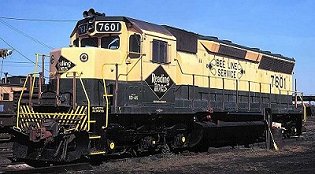EMD: SD45
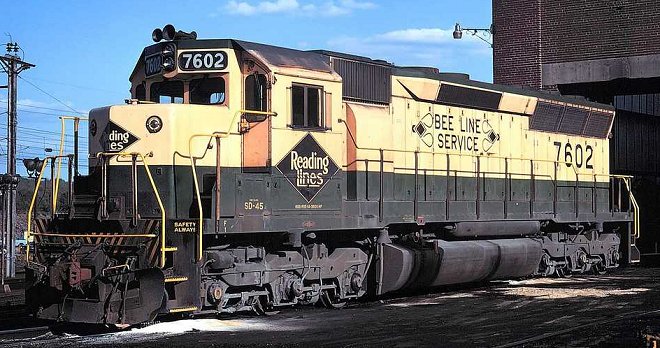
1967 was the year of the six-axle locomotive on the Reading. In addition to acquiring the Alco Century 630 and GE U30-C units, the Reading also took delivery of 5 SD-45 locomotives from EMD. Numbered 7600 through 7604, these were the highest-numbered locomotives on the railroad, and with their 3600 horsepower rating, they were also the most powerful.
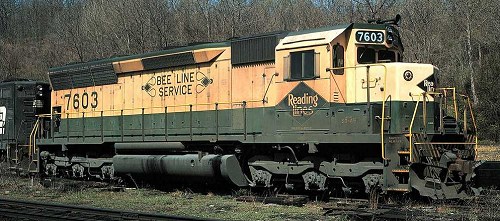 Like most of the Readimg's six-axle locomotives, the SD-45s wore the "Bee Line Service" logo on the long hood. Continuing the practice of trading in older locomotives to finance the acquisition of new power, the Reading traded in EMD FP-7 #906 and Baldwin AS-16s #577, 578, 579 and 582. The five Reading's SD-45s were delivered with dual control stands in the cab, a feature unique among the 1260 units produced by EMD. To allow the necessary space for this equipment, the front windshield was built out by eleven inches, as can be seen by the detail photo below. Most EMD locomotives had the windows flush with the cab front (compare with photos of the GP35 locomotives).
Like most of the Readimg's six-axle locomotives, the SD-45s wore the "Bee Line Service" logo on the long hood. Continuing the practice of trading in older locomotives to finance the acquisition of new power, the Reading traded in EMD FP-7 #906 and Baldwin AS-16s #577, 578, 579 and 582. The five Reading's SD-45s were delivered with dual control stands in the cab, a feature unique among the 1260 units produced by EMD. To allow the necessary space for this equipment, the front windshield was built out by eleven inches, as can be seen by the detail photo below. Most EMD locomotives had the windows flush with the cab front (compare with photos of the GP35 locomotives).
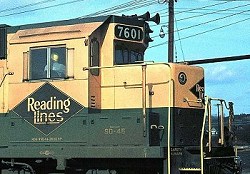 |
|
The SD-45s were used in mainline freight service to all points on the Reading system. Due to their excessive size and weight, they were not used on lighter branch lines like the Wilmington & Northern or Perkiomen lines. As was common practice on the Reading, they were often paired with a four-axle unit such as a GP30 or GP35, though they could be occasionally seen hauling a train as a single unit. Although plagued by mechanical problems throughout their service life, all five units continued to work on the Reading through April 1976 when they were conveyed to Conrail.
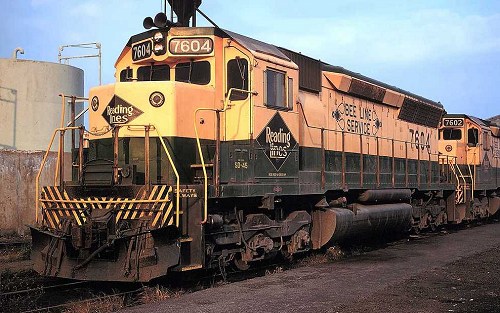 MODELING NOTES: The most obvious issue with modeling the Reading's SD-45s is the built-out locomotive cab. While this could be fabricated with strip styrene, one must also note the "overhang" of the cab roof that angles from the numberboard to the cab side. The units were also delievered with snowplow pilots as can be seen in these photos. These big locomotives are suited to a mainline layout from 1967 through 1976, running in multiple-unit configuration hauling a long train for maximum effect.
MODELING NOTES: The most obvious issue with modeling the Reading's SD-45s is the built-out locomotive cab. While this could be fabricated with strip styrene, one must also note the "overhang" of the cab roof that angles from the numberboard to the cab side. The units were also delievered with snowplow pilots as can be seen in these photos. These big locomotives are suited to a mainline layout from 1967 through 1976, running in multiple-unit configuration hauling a long train for maximum effect.
Did You Know?
Downloads
 A variety of Reading Company operations related documents, etc. that may be of use in your modeling efforts.
A variety of Reading Company operations related documents, etc. that may be of use in your modeling efforts.
 A variety of Reading Company operations paperwork, such as train orders, clearance forms, etc. that will help you operate your Reading layout in a prototypical manner.
A variety of Reading Company operations paperwork, such as train orders, clearance forms, etc. that will help you operate your Reading layout in a prototypical manner.
 Public Timetables, Employe Timetables, and Rulebooks that provide much useful operational information.
Public Timetables, Employe Timetables, and Rulebooks that provide much useful operational information.
 Signs, billboards, and other FREE goodies for your use. We ask only that you help spread the word about The Reading Modeler!
Signs, billboards, and other FREE goodies for your use. We ask only that you help spread the word about The Reading Modeler!

